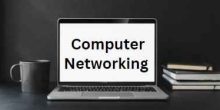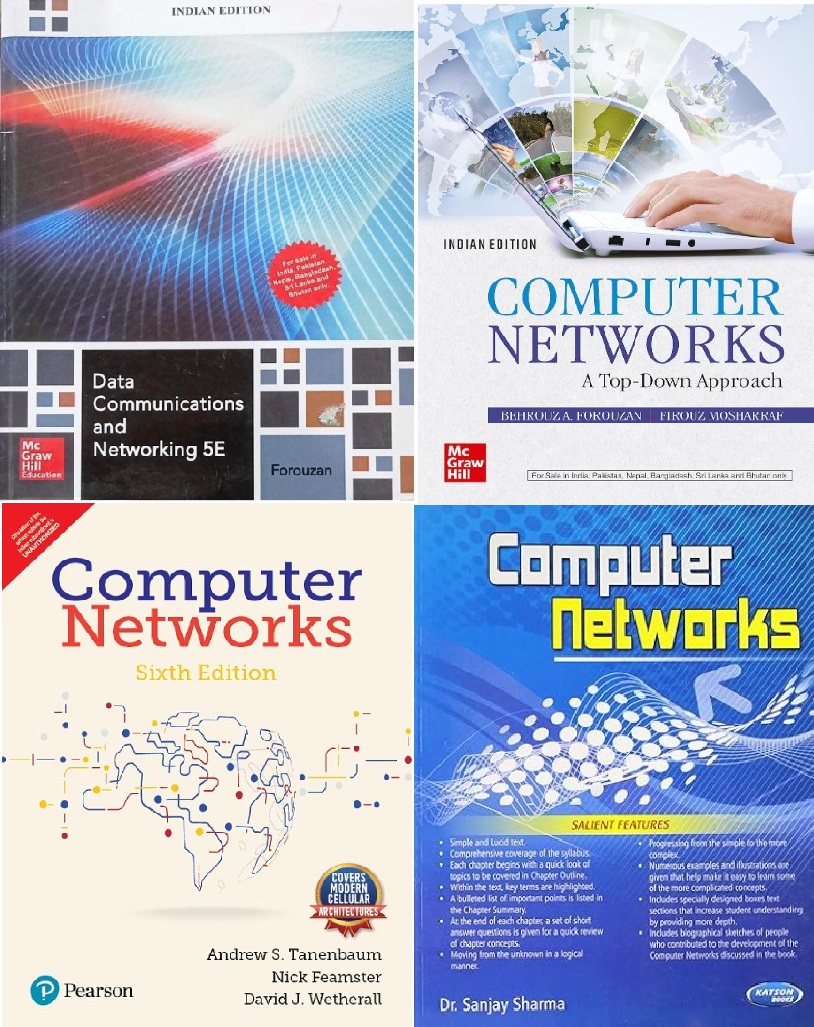Unit 1
Introduction to Data Communication Definition: Effectiveness, Basic Communication Components. Network Architecture Definition, History, Criteria, Goals and Applications of Networks, Categories of networks, Organization of the Internet, ISP, Protocols and standards, The OSI reference model, TCP/IP protocol suite, Network devices and components. Network topology design, Types of connections.
Q161 – In fiber optics a pulse of light indicates ………………..
1 bit
0 bit
1 byte
8 bits
Ans – (1)
Explanation –
In fiber optics communication, a pulse of light typically indicates the transmission of 1 bit of data.
Q162 – _________ uses four pairs of voice-grade, or higher, twisted-pair cable.
100Base-TX
100Base-FX
100Base-T4
none of the above
Ans – (3)
Explanation –
100Base-T4 uses four pairs of voice-grade (Category 3) or higher twisted-pair cable to achieve 100 Mbps speeds. This was designed to allow Fast Ethernet over lower quality cables but is less common than 100Base-TX and 100Base-FX.
Q163 – _________ uses four twisted pairs.
1000Base-SX
1000Base-LX
1000Base-T
None of the above
Ans – (3)
Explanation –
1000Base-T uses four twisted pairs of Category 5e or higher twisted-pair cable to achieve Gigabit Ethernet speeds (1 Gbps).
Q164 – A _______ LAN allows several LANs to be connected.
Backbone
Wireless
Wired
None of the above
Ans – (1)
Explanation –
A backbone LAN is a high-speed network that connects multiple smaller networks or LAN segments together. It serves as a central pathway or link between different LANs within an organization or across different locations.
Q165 – A backbone LAN is usually a ______.
Bus
Star
Either (a) or (b)
Neither (a) nor (b)
Ans – (3)
Explanation –
Star configuration – In a star topology, each device (LAN segment or LAN) is connected directly to a central hub or switch. The central hub or switch acts as the backbone of the network, facilitating communication between different LAN segments or devices.
Bus configuration – In a bus topology, all devices are connected to a single central cable (the bus), where each end of the cable is terminated with a resistor. However, bus topology is less commonly used as a backbone LAN due to its limitations in scalability and performance compared to a star topology.
Q166 – _________ is just a connector.
An active hub
A passive hub
Either (a) or (b)
Neither (a) nor (b)
Ans – (2)
Explanation –
A passive hub is simply a connector that allows multiple devices to be connected together. It does not amplify or regenerate signals. Data transmitted from one device is simply repeated to all other devices connected to the hub without any signal enhancement.
An active hub not only serves as a connector but also regenerates signals before sending them out to other connected devices. It requires power to operate and can amplify signals to maintain the quality of data transmission over longer distances.
Q167 – IEEE 802.1d specification, defines _________ criteria for a transparent bridges.
two
three
four
none of the above
Ans – (2)
Explanation –
The three criteria defined by the IEEE 802.1d specification for transparent bridges are
Frame Filtering – The bridge filters frames, forwarding them only to the segment of the network where the destination address is located, reducing unnecessary traffic on other segments.
Learning – The bridge learns the locations of devices on the network by examining the source address of incoming frames. It updates its forwarding table to keep track of which devices are on which network segments.
Loop Avoidance – The bridge uses the Spanning Tree Protocol (STP) to prevent loops in the network. Loops can cause broadcast storms and multiple copies of frames to circulate, so STP dynamically adjusts the network topology to prevent this.
Q168 – In a bridged LAN, the _______ algorithm creates a topology in which each LAN can be reached from any other LAN through one path only.
Spanning tree
Binary tree
Unary tree
None of the above
Ans – (1)
Explanation –
The spanning tree algorithm is an important protocol used in network design to ensure that there are no loops in a bridged LAN.
The Spanning Tree Algorithm is a network protocol designed to prevent loops by creating a spanning tree within a network of connected Ethernet bridges (switches). This protocol is defined by the IEEE 802.1D standard.
Q169 – A ________ link acts as a LAN in a remote backbone connected by remote bridges.
Point-to-point
Multipoint
Multidrop
None of the above
Ans – (1)
Explanation –
In network terminology, a point-to-point link refers to a direct connection between two network devices, typically used to connect remote locations. This kind of link is crucial in the context of remote backbones connected by remote bridges.
A point-to-point link establishes a dedicated communication path between two endpoints. Unlike multipoint or multidrop links, which involve multiple devices sharing the same communication medium, a point-to-point link ensures a direct and exclusive connection. This results in more reliable and predictable communication.
Q170 – Bits can be send over guided and unguided media as analog signal by
Digital modulation
Amplitude modulation
Frequency modulation
Phase modulation
Ans – (1)
Explanation –
Digital modulation is the process of converting digital data (bits) into analog signals. This is essential for transmitting digital information over various media, including both guided (like cables) and unguided (like wireless) media. Digital modulation techniques include methods such as:
- Amplitude Shift Keying (ASK): A form of amplitude modulation where the amplitude of the carrier signal is varied according to the digital data.
- Frequency Shift Keying (FSK): A form of frequency modulation where the frequency of the carrier signal is varied according to the digital data.
- Phase Shift Keying (PSK): A form of phase modulation where the phase of the carrier signal is varied according to the digital data.
Q171 – The process of converting analog signals into digital signals so they can be processed by a receiving computer is referred to as
modulation
demodulation
synchronizing
digitizing
Ans – (4)
Explanation – Digitizing, or digitization, is the process of converting analog signals into digital signals.
This is typically done by sampling the analog signal at regular intervals and then quantizing the signal to assign it a discrete digital value. This allows the analog information to be represented in a form that can be processed, stored, and transmitted by digital systems, such as computers.
Q172 – Which of the following is considered a broadband communication channel?
Coaxial cable
Fiber optics cable
Microwave circuits
All of above
Ans – (4)
Explanation –
Coaxial Cable – Often used for cable television and internet services, coaxial cables can carry a wide range of frequencies and support high data transfer rates, making them suitable for broadband communication.
Fiber Optics Cable – Fiber optics cables use light to transmit data, which allows for extremely high data transfer rates and bandwidth, making them an ideal medium for broadband communication.
Microwave Circuits – Microwave communication uses high-frequency radio waves to transmit data over long distances. It supports high bandwidth and data rates, which qualifies it as a broadband communication channel.
Q173 – Loss in signal power as light travels down the fiber is called?
Attenuation
Propagation
Scattering
Interruption
Ans – (1)
Explanation –
Attenuation refers to the reduction in signal strength as it travels through a medium, such as an optical fiber. In fiber optics, attenuation can be caused by several factors including absorption, scattering, and bending losses. This loss of signal power can affect the quality and reliability of data transmission over long distances.
Q174 – Which of the following devices modulates digital signals into analog signals that can be sent over traditional telephone lines?
Router
Gateway
Switch
Modem
Ans – (4)
Explanation –
A modem (short for modulator-demodulator) is a device that converts digital data from a computer or other digital device into analog signals that can be transmitted over traditional telephone lines. It also converts incoming analog signals back into digital data that the computer can understand. This process allows digital information to be sent and received over analog communication systems.
Q175 – In _______ transmission, bits are transmitted simultaneously, each across its own wire.
Asynchronous serial
Synchronous serial
Parallel
(a) and (b)
Ans – (3)
Explanation –
In parallel transmission, bits are transmitted simultaneously, each across its own wire.
Parallel Transmission – In parallel transmission, multiple bits are sent simultaneously over multiple channels (wires). For example, an 8-bit byte would be transmitted using 8 separate wires, one for each bit, allowing the entire byte to be sent at once. This method is often used for short-distance communication due to its higher speed but becomes impractical for long distances because of signal degradation and synchronization issues.
Asynchronous Serial and Synchronous Serial – Both of these methods involve transmitting bits sequentially, one bit at a time, over a single channel (wire). Asynchronous serial transmission sends data without a shared clock signal, using start and stop bits to signal the beginning and end of each byte. Synchronous serial transmission uses a shared clock signal to synchronize the transmission of bits.
Q176 – In _______ transmission, bits are transmitted over a single wire, one at a time.
Asynchronous serial
Synchronous serial
Parallel
(a) and (b)
Ans – (4)
Explanation –
Asynchronous Serial Transmission – In this method, bits are transmitted one at a time over a single wire without a shared clock signal. Instead, start and stop bits are used to indicate the beginning and end of each byte of data, allowing the receiving device to understand when to start and stop reading the bits.
Synchronous Serial Transmission – This method also transmits bits one at a time over a single wire, but it uses a shared clock signal to synchronize the transmission. Both the sender and the receiver use this clock signal to ensure that bits are read at the correct times.
Parallel Transmission – In contrast, parallel transmission sends multiple bits simultaneously across multiple wires.
Q177 – Asynchronous Transfer Mode is ______ technology.
Narrow band
Packet switching
Circuit switching
None
Ans – (2)
Explanation –
Asynchronous Transfer Mode (ATM) is a packet switching technology.
Asynchronous Transfer Mode (ATM) is a high-speed networking standard designed for the efficient transmission of data, voice, and video. ATM uses small fixed-size packets called cells to transmit information, which allows for the integration of different types of traffic (such as voice, video, and data) over the same network.
Packet Switching – In packet-switched networks, data is broken into packets before being transmitted. Each packet can take its own path to the destination, where they are reassembled into the original message. ATM uses this method, specifically using cells (small fixed-size packets), to ensure efficient and fast transmission.
Narrow Band – This term refers to communication channels with a limited bandwidth, typically insufficient for high-speed data transfer.
Circuit Switching – This method involves establishing a dedicated communication path between two points for the duration of the transmission. This is common in traditional telephone networks but not in ATM, which uses packet switching.
Q178 – Which of the following to be considered as a broadband communication?
Fiber optics
Multiplexing
Microwave circuit
Both a and c
Ans – (4)
Explanation –
Both fiber optics and microwave circuits are considered broadband communication technologies.
Fiber Optics – Fiber optic cables use light to transmit data, allowing for extremely high data transfer rates and bandwidth. This makes them ideal for broadband communication, capable of handling large amounts of data over long distances with minimal loss.
Microwave Circuits – Microwave communication uses high-frequency radio waves to transmit data over long distances. It supports high bandwidth and data rates, which qualifies it as a broadband communication channel.
Multiplexing – While multiplexing is a technique used to combine multiple signals for transmission over a single communication channel, it is not itself a communication medium. Rather, it is a method that can be used with various types of media to increase efficiency.
Q179 – What does UTP stands for?
Unshielded Twisted pair
Uniformly twisted pair
Unshielded Connecter pair
None
Ans – (1)
Explanation –
Unshielded Twisted Pair (UTP) is a type of copper cabling used in telecommunications and computer networks. It consists of pairs of wires twisted together to reduce electromagnetic interference from external sources and crosstalk between adjacent pairs. UTP cables are commonly used in Ethernet networks and telephone systems.
Q180 – What is the major factor that makes coaxial cable less susceptible to noise than twisted-pair cable?
Inner conductor
Diameter of cable
Outer conductor
Insulating material
Ans – (3)
Explanation – Coaxial cable consists of a central conductor, which carries the signal, surrounded by an insulating layer (dielectric), and then an outer conductor (shield). The outer conductor is typically a metallic foil or braided wire mesh that provides shielding from external electromagnetic interference (EMI) and also helps contain the signal within the cable, reducing signal loss and noise.
In contrast, twisted-pair cable (such as UTP) consists of pairs of insulated copper wires twisted around each other. While twisted pairs provide some resistance to noise due to the twisting, they are generally more susceptible to noise compared to coaxial cables because they lack the additional shielding provided by the outer conductor.



